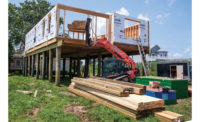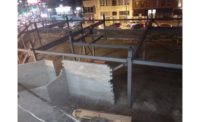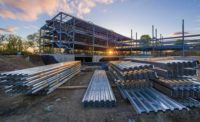Prices typically rise after a natural disaster as demand spikes for building materials, but President Donald Trump's 20% import tariffs on imported Canadian softwood timber will drive those costs even higher. The price of lumber has jumped 30% nationwide since the beginning of the year.
"The experience of our builders and homeowners in and around such an event has almost always been that prices spike on essential building materials but in a very localized area," says David Logan, the National Association of Homebuilders' director of tax and trade policy analysis.
Plywood and drywall are two building items that will be in high demand for home repairs. Both could face further price spikes if the trade war intensifies. China continues to be the leading supplier of plywood to the U.S., despite U.S. tariffs on a range of Chinese wood products implemented last year. Additional 10% tariffs on $200 billion worth of Chinese goods were announced Sept. 23. The Chinese tariffs are set to rise to 25% by the end of the year.
That's on top of tariffs on $50 billion in Chinese goods that went into effect in August. In 2017, U.S. companies imported $1.14 billion in plywood from China, or 41.6% of all plywood imports that year, according to data from the Commerce Dept. Through July, imports from China have been down 14.5% from the same period last year. Commerce data also shows that Canadian lumber imports have consistently been the largest foreign supplier in the U.S. softwood lumber market, accounting for about 28% of U.S. sales per year over the past decade.
"We expect prices to spike. Anyone that says they know how much that will rise, they’re being at least partially untruthful," says NAHB's Logan. "The consumer price index and the producer price index that the Bureau of Labor Statistics puts out are not granular to that level. What we have to look at are national trends."
An NAHB study before Florence found tariffs could increase the price of a new home by $9,000, and the price of a multifamily unit to increase by $3,000.
The Commerce Dept. and the Office of the U.S. Trade Representative did not have any comment on the situation, but Trump reiterated Sept. 26 that his administration is committed to the tariffs and what Trump has characterized as the righting trade imbalances with NAFTA partners such as Canada and trade rivals such as China. Lumber is not part of NAFTA.
Trump said he rejected a meeting about NAFTA with Canadian Prime Minister Justin Trudeau because Trudeau was unwilling to budge in negotiations over revisions to NAFTA.
"Because his tariffs are too high and he doesn't seem to want to move and I've told him forget about it," Trump said Sept. 26 in a wide-ranging press conference.
NAHB has talked with 171 members of the U.S. House of Representatives and 16 senators from both parties who signed a letter calling on Commerce and the U.S. Trade Representative to negotiate a new Canadian softwood timber agreement, but NAHB doesn't expect much movement until after the midterm elections.
"There hasn’t been any movement over the last few months," NAHB's Logan said. "It looks like it’ll be a protracted ordeal which is what has happened in prior episode where it took three or five years to hammer something out (to agree to a new softwood timber deal). We’re in the unfortunate position this go around of having the administration trying to renegotiate NAFTA and they will not reopen negotiations on this issue until NAFTA is hammered out."






Post a comment to this article
Report Abusive Comment